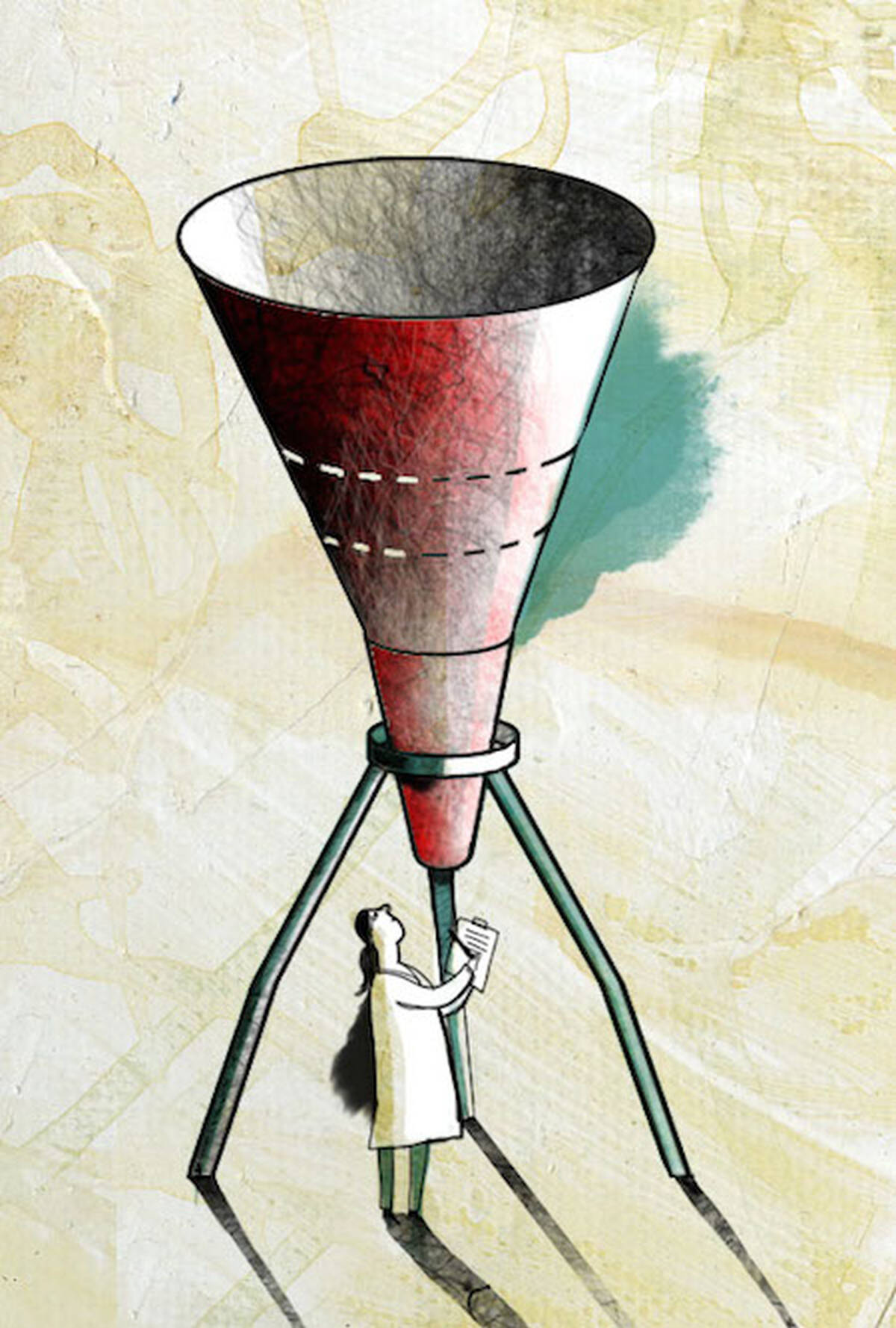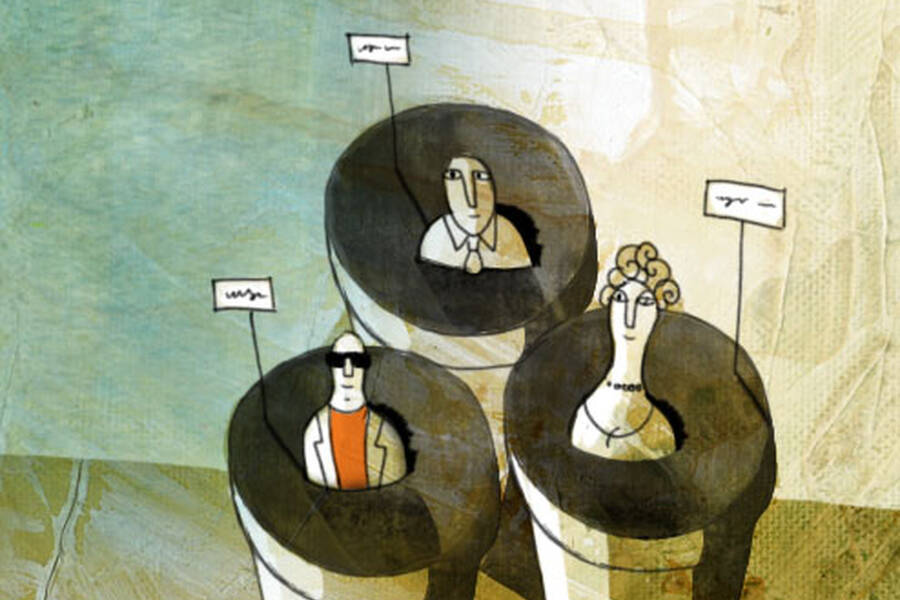Entrepreneurship Innovation Jun 15, 2015
Overcoming the “Buzzsaw of Quiet” around Your Startup
Tips for how to optimize the product engine.

Yevgenia Nayberg
One look at the app store tells you that, with about 1.5 million products available, build-out is not the choke point for most digital startups. Each of these products has gone through ideation, development, and testing before launch. But most of them will fail to attract and keep users.
Sean Johnson, an adjunct lecturer of marketing at the Kellogg School and a partner at Founder Equity and the digital startup incubator Digital Intent, believes that to stand out in this crowded field, entrepreneurs should keep their focus on an often-overlooked area of digital product development: building a strong customer base.
“If you ask a tech startup what their marketing plan is,” Johnson says, “more often than not, it’s nonexistent, or it’s some big notion of word of mouth and it’ll go viral—‘We’re going to get written up in Tech Crunch or Product Hunt,’ and then it’s a movie montage: money, money, money, and then I’m on a boat.”
The real world, of course, rarely functions that way. What usually happens is that traffic to a startup’s site spikes in the few days after launch, and then returns to pre-launch levels very quickly. Johnson refers to this post-bump period as “the buzzsaw of quiet,” when companies realize that their cool idea may not instantly translate into customer traction.
Fix Your Funnel
Success is a matter of converting customers, a process Johnson visualizes in the context of a funnel. At the top of this funnel is acquisition: people visit a company’s website or other channels. At the bottom of the funnel is revenue: customers engage in activity that generates revenue for the company. But there is a lot more to the funnel than just its two openings.
“What you’ll find is a lot of companies look at acquisition and then revenue,” Johnson says. “The middle of it is sort of a black box for them.” This middle—according to Dave McClure’s AARRR startup metrics model—consists of three very important steps of the process: activation, when people have a good first-time experience and sign up; retention, when those sign-ups come back; and referral, when they tell their friends.
“Most startups just launch and leave it up to their users to figure out what content they should put in there. Then they say, ‘Oh, we didn’t get enough people coming in. Darn.’”
These middle steps—what Johnson calls “the product engine”—are where the business succeeds or fails: get the engine working and every dollar spent will go further, leading to more revenue out the bottom of the funnel. To do this, Johnson recommends startups launch small, focus on tactical acquisition—where the startup drives just enough users into the top of the funnel to see how well the product engine is working—and control as many aspects of the user experience as possible to facilitate future conversion, retention, and referral.
Launch Small and Experiment
While a startup in a crowded tech field may only have one chance to make a first impression, it can control when it makes that impression—and save itself the risk and expense of putting a suboptimal product in front of a large number of new users. Johnson recommends launching to a small group of people, finding out what does and does not work about the product, and making the product better step by step.
Organizing for a process of rapid iteration rather than a big launch requires aligning the founders behind the idea, which is not always easy. “You want to make huge product decisions when you’re dealing with low-fidelity or low-input steps like product descriptions, mockups, or clickable prototypes,” Johnson says. “The goal with small launches and iteration is actually to limit waste.”
“It’s important for the founder to remind the team to look at the data to inform decisions,” Johnson says. “Remind them to go out of the building and actually talk to people to validate those decisions and get to the why behind those decisions; remind them to not get discouraged—most tests on the engine will fail. For example, it will take several iterations to really nail your referral loop.”
A culture of experimentation acknowledges that most experiments are going to fail, but the ones that do pay off will offset that low success rate. “If you’re running ten experiments a week and you’re getting a five-percent lift from one of them, you’re a completely different company and it compounds,” Johnson says. “Over time, five percent plus five percent, that’s a material difference.”
Focus on Tactical Acquisition
Experiments need subjects, and those can be found and optimized through direct contact with early users.
“Focus on tactical acquisition,” Johnson says. “Get enough people into the top of your funnel so that you can study their behavior through the funnel, then talk to them. Don’t just look at their analytics, but have conversations with them and then make iterations on your product based on what you learned.”
It is also key, early in the process, to ensure that even new users can internalize why the core experience of the product is useful for them—what Johnson calls the “lightbulb moment.”
Onboarding the customer is critical to new users reaching that lightbulb moment. If new users see a blank screen with no tips, demos, advice, or sample content, they will be less likely to activate. “Most startups just launch and leave it up to their users to figure out what content they should put in there,” Johnson says. “Then they say, “Oh, we didn’t get enough people coming in. Darn.”
Johnson uses the example of how companies design their CRM systems. Most UX designers will envision what the product looks like when it is fully realized by users, but they rarely give enough though to how the system looks the first time a user encounters it, with no contacts or data.
Control the User Experience
One way to convince users of a product’s functionality early on—whether in a marketplace business or a CRM—is to seed the network as a way to help people understand how to use the tool or app. For highly networked environments like Reddit or Ello, where utility is determined by how many—and how actively—people use the product, there need to be active users. If people wander into a ghost town, there is little reason to spend time waiting for others to join the party. Proactive companies, including Reddit, seed their networks to project the image of vitality until users take the reins.
“They realized the important artifact of Reddit wasn’t the user, it was the link,” Johnson says. “All users cared about was coming to Reddit and finding cool stuff there, and coming back the next day for new cool stuff.”
Controlling the user experience extends to design as well. Many companies make the common mistake of equating experimentation with adding features to the product. The real focus, Johnson says, should be on getting the core experience right.
“If you are not getting the response you want from users, the answer isn’t to put a bunch of other junk on it,” Johnson says. “If the core experience is not good, people are not going to use it because it does this other side thing.”
Advantages of the Fixed Funnel
The tech space is attractive for startups because the barriers to entry are low, entrepreneurs can move quickly and iterate on their product idea, and the kinds of data that provide customer feedback are easily available. But if conditions such as these are available to everyone, are they really that helpful? In some ways, yes—speed and accuracy of decision making can only help. But it has made the tech space more competitive.
In a crowded environment, companies are not just competing against products with similar functionality, but against every other product in the market. Customers are constantly asking why they should stop what they are doing and adopt a new product. Strong activation, retention, and referral processes are an advantage that is unique to the company and the product around which it is built.
“Optimizing customer conversion gives you options,” Johnson says, “because the funnel flows all the way down. It’s also more protectable. It’s a lot easier to ape my advertising strategy than it is to ape my customer-referral system. That is a much harder thing for a competitor to come in and copy.”



